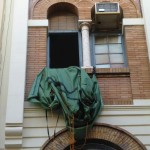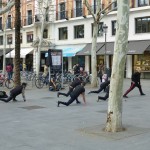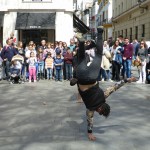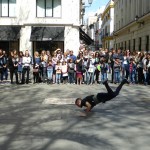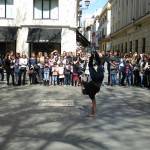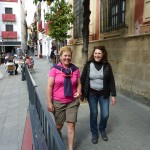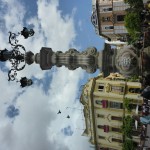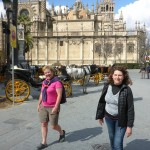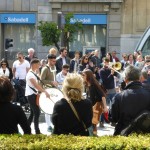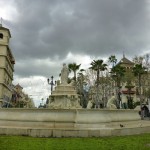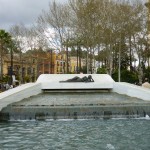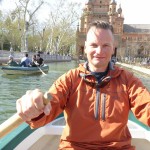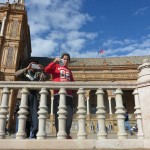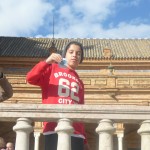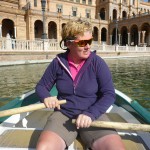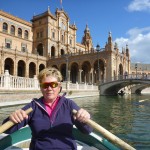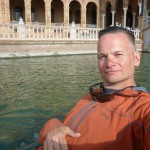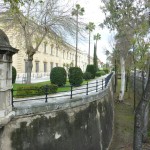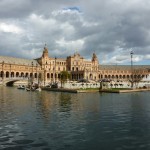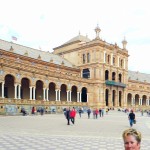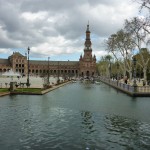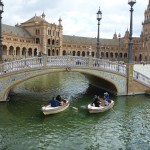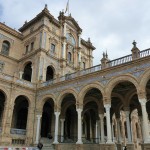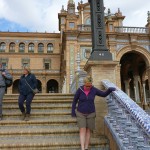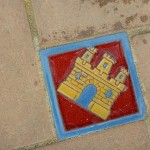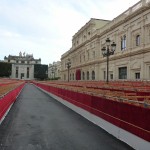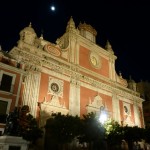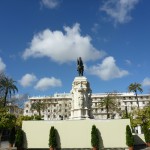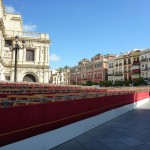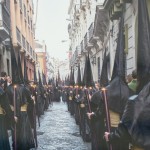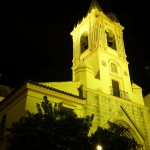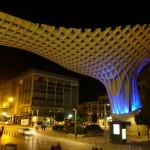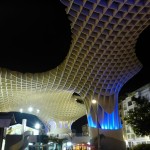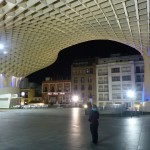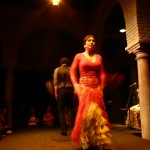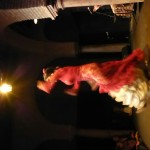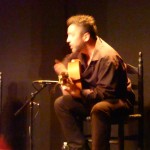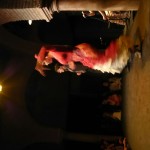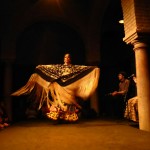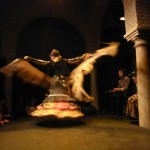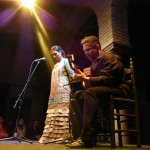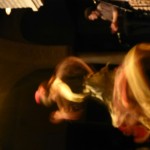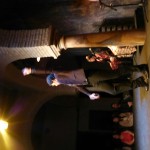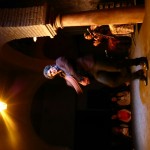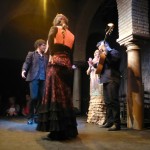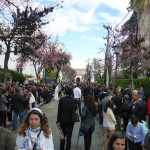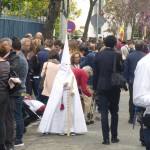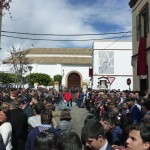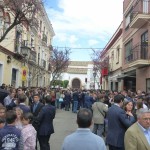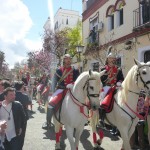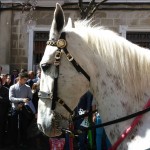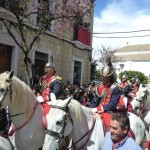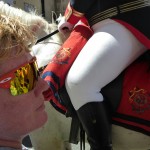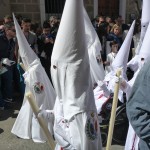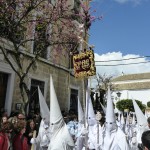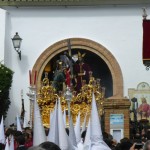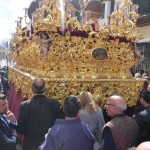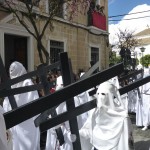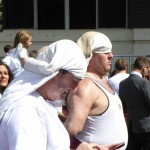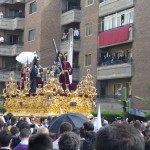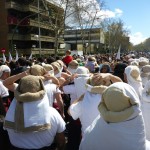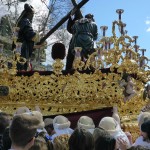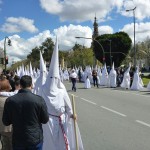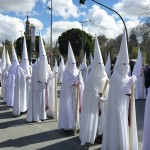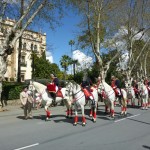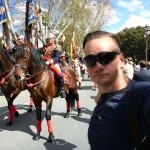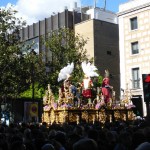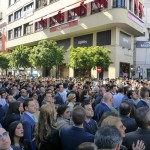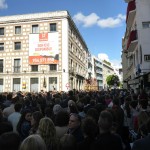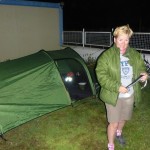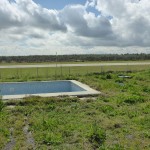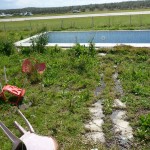Saturday 19th March
Daz posted a question about condensation in tents, apparently a common and well known problem. Some travellers pack up first thing and then get everything out at lunchtime to dry – what a pain that is. ‘Chavs r us’ – we’ve got our tent hanging out of our Hostel window. We know how to lower the tone in a good area.
Today our last workaway hosts, Chris and Des, are visiting us in Seville. We’re expecting them for 1pm so Daz is busy planning a sightseeing itinerary! It’s 1245pm and we’re already waiting for them in the Plaza Nuevo – Daz insisted we be early. There’s no sign of them but there’s a cool bunch of young lads giving a ‘street dance’ performance. They’re very impressive.
We get a call from Chris, they’re in Seville but haven’t found anywhere to park. I was worried this would be a problem; it’s Semana Santa and Seville will be ‘chocka’. It’s not long, they’re parked and we meet. It’s so lovely to see them. We find somewhere to eat and catch up on their news.
They’ve had their friends visit, they’ve had the last bedroom tiled, the old blue doors removed and even found the box of bulbs that Des had misplaced. Then under the guise of finding coffee and cake Daz manages to march them by some of Seville’s highlights including the Cathedral. They’ve visited Seville before but for Ikea and Costco shopping expeditions not for sightseeing. Too soon they have to leave, they’re going to Costco before heading home. It’s been lovely to see them; they’re so entertaining. Des plays the part of ‘grumpy old man’ to perfection whilst Chris is the constant optimist, laughing at the ‘schedules’ Des tries to implement to bring order to their lives!! I hope we might be able to meet them again before leaving Spain/Portugal.
After their visit we head to the Plaza España – Plaza de España is a semi-circular brick building, Renaissance/neo-Moorish in style, with a tower at either end (tall enough to be visible around the city, these towers – north and south – are major landmarks). In front of the building, following the curve of its façade, is a 500-metre canal crossed by four bridges, and in the centre of it all is the Plaza itself. You can rent small boats to row in the canal – the Plaza is known as “the Venice of Seville”. Daz wants to hire a rowing boat but it’s only because he’s been watching other tourists unable to row their boats (many of them face the wrong way and can’t manage both oars) and he wants to reassure himself that his technique is flawless. And of course it is! We’re rowing along and a young lad drops a 20€ note. Daz rows back and rescues the note from the floor of the canal. The parents are very appreciative.
Measuring 50,000 square metres, the Plaza is the size of five football pitches. The building has a ground level portico and first-floor balustrade with balconies stretching along its length. For taking photos, the balconies are a prime spot, reached by staircases, as you can get the whole sweep of the building. The magnificent central balcony is especially impressive.
All along the wall by the canal are 48 alcoves with benches, one for each province of Spain, each with a relevant tableau and map, all designed on colourful azulejos (painted ceramic tiles). Spanish tourists have photographs taken of themselves with family and friends on their home province’s bench. In a further regional reference, the four bridges represent the four ancient kingdoms of Spain: Castille, Aragon, Navarre and Leon.
According to legend, Sevilla was founded by Hercules and its origins are linked with the Tartessian civilisation. It was called Hispalis under the Romans and Isbiliya with the Moors. The high point in its history was following the discovery of America in 1492. For all its important monuments and fascinating history, Sevilla is universally famous for being a joyous town. While the Sevillians are known for their wit and sparkle, the city itself is striking for its vitality. It is the largest town in Southern Spain, the city of Carmen, Don Juan and Figaro.
Sevilla lies on the banks of the Guadalquivir and is one of the largest historical centres in Europe, it has the minaret of La Giralda, the cathedral (one of the largest in Christendom), and the Alcázar Palace. Part of its treasure include Casa de Pilatos, Torre del Oro, the Town Hall, Archive of the Indies (where the historical records of the American continent are kept), the Fine Arts Museum (the second largest picture gallery in Spain) , plus convents, parish churches and palaces.
In Sevilla, you will want to visit the old city, with the Cathedral and the Giralda tower at its heart. (You can climb the steps inside the tower for a magnificent view of the City). Very close by are the royal Mudéjar palace known as the Alcazar with marvellous gardens and the Santa Cruz quarter, with cramped streets, flowered balconies, richly decorated facades, hidden patios… Other sights not to be missed are, in the old city, the Casa de Pilatos, a large sixteenth-century mansion where Mudejar, Gothic and Renaissance styles blend harmoniously amidst exuberant patios and gardens and, crossing the Triana bridge over the large Guadalquívir River, the lively popular quarter of Triana with charming narrow streets around the church of Santa Ana and traditional ceramic factories.
In the evening we visit a Flamenco show.
El Museo del Baile Flamenco – the Museum of Flamenco Dance is an impressive venue for some of Seville’s best flamenco. Located in the Santa Cruz quarter and just a few steps from the Plaza Alfalfa. The stars tonight were Zaira Santos and Oscar ole Los Reyes (the dancers) and Merceoles Cortes and Joroh Flores (the singer and guitarist). It was breathtaking, exhilarating and mesmerising – we’ve never seen anything like it before and were entranced by the performance. An unmissable experience.
Sunday 20th March
It’s palm Sunday today. Everyone we see is suited and booted. There are large family groups and everyone is dressed in their Sunday finest. If I felt like a chav hanging our tent out of the window, I feel really chavy now and seriously underdressed but there’s nothing to be done about it.
Holy Week (Semana Santa) is the biggest religious celebration of the year in Spain, which means public holidays, a good deal of eating and drinking and lots of processions. Easter is a time for Spaniards to take to the streets and watch elaborate reenactments of the Passion, as well as enjoy some time off work in the company of their families and friends.
Elaborate processions take place throughout Holy Week. Associations known as cofradías or ‘brotherhoods’ (whose members take part in the processions) are a strong tradition in Spain, with many dating back to the Middle Ages. Semana Santa processions are also known as ‘penance processions’ and involve members of the brotherhood (nazarenos) parading from their church to the city’s cathedral. Each cofradia has up to 3,000 nazarenos (the robed, hooded figures; penitents carry crosses), taking as long as 90 minutes to file past.
People taking part in Semana Santa processions dress in traditional capirote; the tall conical hat which also covers their faces, as well as in belted robes. Capirotes used to be reserved for people doing penance – as a sign of atoning their sins, they would walk through the town wearing the hat, their faces covered so they could not be recognized as sinners.
Although strikingly similar, they have nothing to do with the hoods worn by the Ku Klux Klan.
Women often wear the mantilla, a black lace veil worn high on the back of the head. Alicante recently issued fashion guidelines for women taking part in the city’s Easter processions and made it clear red lipsitck and skirts above the knee were definitely not allowed.
In most Easter processions, participants carry large floats, or pasos, that are adorned with religious sculptures depicting Jesus or Mary, some by renowned Spanish artists. The floats are festooned with flowers and candles and are the focal point of the procession. Many brotherhoods have owned and preserved their pasos for hundreds of years. These pasos are carried by costaleros, who bear the pasos on their shoulders for hours on end. A titanic effort that is rewarded by the spontaneous applause of the public.
If you are after the most glamorous, ornate and lively Semana Santa parades, look no further than Andalusia, especially the cities of Seville and Málaga. The region’s flamenco heritage seeps into its Easter celebrations, making for a fest like no other in Spain and one that attracts the most tourists.
Seville holds some of the biggest Holy Week processions including La Madruga (dawn), a series of processions that take place during the night of Maundy Thursday and into the morning of Good Friday, a highlight of Semana Santa for many spectators. Listen out for the saetas, or bursts of flamenco from people on balconies along the procession route who are so moved by the spectacle they have to express their lament.
In addition to the processions another typical activity during Holy Week is a visit to the churches in the morning before the processions leave to view the floats/pasos in their glory.
We think there’s a procession starting at 1pm and we try and work out the start point and route. Finally we work it out and head to the start point. It’s already gone 1pm but there’s no sign of the procession but the streets are increasingly crowded with people as we near the start.
Finally we can see the church with the doors firmly closed. It’s really crowded here and we stand and wait. Finally we ask a young lad what time the procession might start. He says if they decide to go, it should be 1.30ish. This comes and goes. Nothing is hsinening and then the crowd start ‘shushing’ each other until the crowd is silent and then suddenly the crowd erupts in cheers and everyone is hugging each other. Daz and I are looking around for something that might explain this strange behaviour. The Church doors are still firmly closed. We’re completely bemused so we ask another young lad. Many of the crowd are listening to a radio broadcast and La Paz (the procession we’re waiting for) has just confirmed they will march. Apparently if there’s inclement weather the procession is cancelled and after months of preparation this results in tears of disappointment. There was heavy rain last night and there’s been some sporadic raindrops this morning but the heavy rainfall hasn’t materialised.
It’s nearly 2 pm and the crowd starts shifting. Our focus has been trained on the church doors so we’re surprised when we turn the other way and there’s a troop of horsemen. There’s about 18 of them. They then decide to about face, not an easy task in this narrow street jammed with spectators – a little too close for comfort especially since my nearest horseman is quite a large unit.
Soon the waiting is finished. The mounted band herald the start of the procession; the church doors open and out flood the penitents. They walk passed us, there are literally hundreds of them.
And then comes the pasos followed by an Army section and then a marching band and then more penitents. As the pasos comes out of the church there’s cheering and clapping and as it passes just in front of us many try to touch it.
It’s an incredible sight to behold. There are so many people involved, the huge crowds, 100s of penitents and the bearers. And this is just one procession of 9 today. We look at the route and its incredibly long. It looks as if they don’t finish until 1am.
After the main procession has passed we move off and intercept it at other points along the route. We also watch as a team of costaleros prepare to relieve the current bearers. Finally we decide to head off to our bike but every route we take is barred.
There’s another procession route between us and our hotel and it’s part of the ‘official route’ – from Calle Campana, along Calle Sierpes, in Plaza San Francisco, down Avenida de la Constitucion, to Plaza Virgen de los Reyes by the cathedral, streets common to all the processions where all the spectator stands have been set up. It’s possible to buy a seat here to watch all the processions. For us it would cost 75€ (2 seats) for a day or about 500€ for the week!
Finally we manage to get back to our hotel where we left our bike and bags. We head out of Seville. Everyone is in holiday spirits and are happy to see us on our bike. We’ve got about 20km to cycle to La Juliana, an aerodrome on the outskirts of Seville. It’s gone 7pm and the place looks deserted. Chris phoned and made our camping reservation ( we tried and failed because our Spanish is almost non existent) and there was the implication that the place would be packed because of Semana Santa. This place is in the middle of nowhere, the ‘camping’ ground is just a patch of scrub land – no one’s bothered to cut the grass (well weeds actually).
There’s a porta cabin with 2 showers and toilets. And the swimming pool is an empty concrete hole – Nice! I wouldn’t object but the owner is charging more than we’ve paid for proper deluxe camping grounds. Why are we here? Well I thought Daz would enjoy an accelerated freefall course so I booked one for him for his birthday with Skydive Spain. Tomorrow his ground training starts at 0845hrs. Then he can start jumping from the plane. I did a similar course many years ago in La Rochelle but even then my bottle deserted me after several jumps, the last seeing me landing way-off the DZ, in a maize field which was head height. Yes readers you think even then I couldn’t navigate to a huge, open piece of land with runways on it! Actually we had intercom and I was being talked down, ‘right hand down’ etc to control my toggles. Unfortunately there was some confusion and they were directing the wrong person!!! Plus jumping out of planes is pretty terrifying for me! I occasionally think I’m braver than I am and then have to see how much fear I can endure before I puke!

